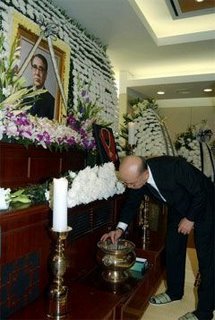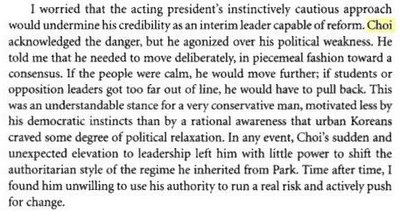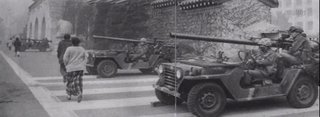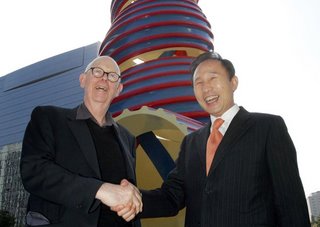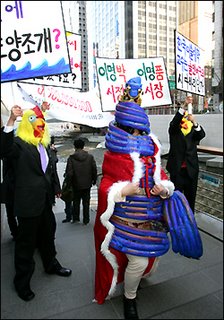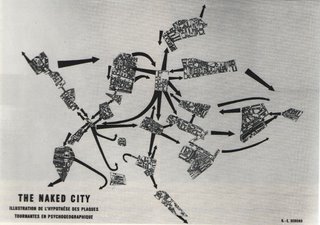A friend passed on a link to Songun Blog a few days ago, and knowing full well that the title referred to North Korea's 'military first' policy, wondered what I was in for. As it featured obviously fake newsreels of Hitler visiting America and a documentary about a massacre carried out in France in 1944 (which was bookended by denunciations of the US, but edited out the fact the atrocity was committed by the Nazis!) it seemed rather humourous. Of course, it's hard to tell sometimes. Anyone who saw this would think it to be a parody of Japanese revisionist arguments, but instead would be shocked to find the writer actually espouses this point of view. So I remained unsure about Songun blog, at least until I saw this video, which is so obviously a ridiculous piss-take on those blaming the US (and Israel) for all of the world's ills ("stealing complete children for sale in Israel"; "guilty of crimes against cats"). Still, I imagine there are those on either side of the political divide who might not find it all that funny. A glance at Songun's blogroll would suggest that mocking North Korean rhetoric is no longer a sport for South Korean expats only - or that there are a lot of Kim Jong-il fans in the English-speaking blogosphere. Take your pick.
Still with rhetoric like "this week 'America' turned up its 300th million redneck warmonger mental retard capitalist aggressor", one is reminded of North Korea's way with words. It's a shame there's no such thing as NorthKorean hiphop, as the wordsmithery found in these statements, in English translation, could make them a breakout success in the global market. At the very least, if there can't be hiphop, Yi Paksa should at least do an album with lyrics taken from broadcasts denouncing the US (not that he would, I imagine, but hearing his voice take on such words would be a thing of awe - and as it could possibly draw on the youthful audience who made Fucking USA so popular, could prove to be rather successful, but only if released after some shocking crime by a US soldier in Korea or a loss to the US in a sporting event).
Of course, US-bashing is not all that Songun blog is about. It also has posted several official North Korean propaganda clips translated into English, which is indeed a service to us all. The introduction also reminds us that the DPRK (or its adherents, or its parodists) can also deliver complimentary compliments to contrast with their insulting insults:
The Dear Leader Comrade Generalissimo Kim Jong Il the brilliant statesman, political genius, prodigious humanist, prolific author, superlative scientist, remarkable film maker, and invincible military commander has been at the helm of the Juche revolutionary cause of the Korean people for a long time.Arrrgh! "A long time?" Why did they have to end such sublime big-upping of KJI on such a dull note? Ah well. At any rate, there are three parts of the documentary "Always working together for the people" posted on the blog (part 1, part 2, part 3), though I doubt you'll really need to watch them all. And yet.... and yet you may feel compelled to. You see, the music is a cross between the synth-y mush heard in Japanese videos of gravura or AV idol photo shoots (something I can see Kim Jong-il being a big fan of - it wouldn't surprise me if he imagines himself being Che Gravura sometimes) and Christmas films from the 1940s or '50s like A Christmas Carol or It’s a Wonderful Life. This warm, yet insipid, slightly bombastic music meshes nicely with the even, monotonous voice which describes the exploits of such a caring, nurturing, and kind leader as Kim Jong-il. I've always had an affinity for this kind of thing - I can think of numerous documentaries or somesuch programs on tv as a child that would, with this monotonous speaking, or a certain timbre of the voice, almost hypnotize me and leave me in a trance-like state. These documentaries embody this par excellence, and I can honestly say they are equivalent to the effect of sinking a bowl of makkeolli. You feel all warm and fuzzy inside - without the headache the next morning. I don't know if the effect is the same in Korean, but it shouldn't surprise anyone that this hypnotic style has been perfected by the North Koreans.
Also worth noting in this documentary is the fact that they never actually let the viewer hear what the great and dear leader are actually saying (for all we know, they're having a passionate argument over whether Akira Fubuki or Minori Aoi is the better AV actress). We don't hear the voices of the speakers or see the rapid editing and constant movement as seen in Leni Riefenstahl's groundbreaking Nazi propaganda film Triumph of the Will (which John Ralston Saul has described as the origin (in form, not in content) of modern advertising), but instead see some longer takes and hear voiceovers -such as is found often in American television news.
To see an example of said American tv news in action, you need only look here. In the video clip found there, from October 16, you can hear this commentary:
In one corner of the globe tonight it is a full scale crisis. North Korea has now proven to the world it is now a nuclear nation. For its neighbours, those in close missile range, that is bad news, as it is for the US government, who worry that it will become at kind of nuclear arms dealership dealing with all the wrong people. Tonight US intelligence has picked up fresh evidence they might be planning another test, on the very same day when we were able to confirm that the first test was indeed the real thing.I guess MSNBC was just hoping no one would put any thought into what 'regularly scheduled' means. How can South Korea be 'taking the threat seriously' by having an air-raid drill when it's a regularly scheduled one? Ah, but no matter, all you need to do is show rapid-fire shots of people running into subways in order to make it seem very, y'know, crisis-like. Follow that by North Korea saying it will defeat the US, and everybody is off to Walmart to buy duct tape.
Today, South Korea was taking the threat seriously. In Seoul, 40 miles from the border, regularly scheduled air-raid drills today, people running for underground shelters. While in the north, Kim Jong-il's second in command told a military rally they would be victorious over the united states.
Fox News was kind enough to also provide a video clip of their story about the civil defense drill here. I include it because, unlike NBC, you can take screen shots:
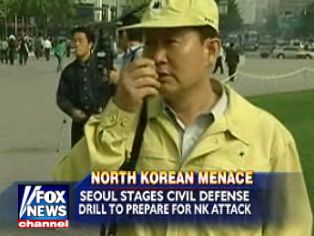


We are told, "This entire city of ten million shut down, there is no traffic on the streets, there are no people on the streets." Strange. By my place traffic continued as usual. Of course, this reporter is not exactly being truthful. There are several people in the streets, including himself and his cameraman. Look behind the man in yellow in the first picture, and you'll see some photographers with a tripod. It seems the media weren't required to seek shelter; they were too busy trying to scare the hell out of people living elsewhere in the world.
And people ask me why I don't watch TV.
These 'news' clips are basically telling Americans that it's a full scale CRISIS, NORTH KOREA WILL DEFEAT US, seoulites are RUNNING for the subways (which is utterly uncommon here) - first we confirm the FIRST TEST was the REAL THING, a genuine NUCLEAR BOMB, and now there are TWO BONGOS, A SCOOTER, AND A HALF DOZEN SOLDIERS near the TEST SITE - ANOTHER TEST could occur in OUR SLEEP! aaaAAAAEEEEIIIIIIEEEEEEAAAAAGHHHHHHH!!! Run! Run to the mall! Max out your credit cards!! (Brought to you by American Express)
Of course, when North Korea does this, its called propaganda.
Speaking of North Korea - hundreds of North Korean propaganda posters can be found here, and information about visual propaganda in North Korea can be found here. Best of all is the gallery of paintings from a book called 'The Peoples Great Leader', which should give some idea of Kim Il-Sung's god-like stature in North Korea. The religious iconography in these paintings is astounding - about the only thing missing is the 'miracle of the loaves and the fish'.
This iconography is not lost on British artist Jonathon Barnbrook:

Do 'spot the difference' in the following image - it is amusing:

In another piece that uses North Korean propaganda in order to critique it, Barnbrook juxtaposes images of children with the following text:
Why do dictators love children?The rest of Barnbrook's work can be found here, while his two series on North Korea can be found here and here. I came upon his work at the Seoul Arts Center in 2004 when his exhibition "Tomorrow's Truths" was displayed there. He does not limit his criticism to North Korean propaganda, but also focuses on American and British corporate/ government propaganda. One of the more moving pieces about North Korea is the one below, which features photos of divided families being reunited, juxtaposed with text by Milan Kundera:
Because 'the past' is more real than 'the future'
And the past is much better than the present created by the dictator
And children have no memory of the past.
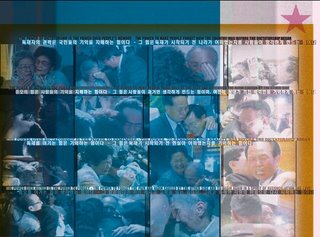
The power of dictatorship is the power over people's memory - the power to make people forget how the country was before the dictatorship began.
The power of hatred is the power over people's memory - the power to make people think only of the past and remember the harm caused by the other side.
The power over dictatorship is the power to remember - the power to remember how reality was before the dictatorship began.
The power over hatred is the power to forget - the power to forget the pain and harm caused by the other side and begin again in a spirit of reconciliation and love.
Seeing as both Koreas have been busy demonizing Japan and the US for quite some time, and the US has been busy demonizing North Korea, Cuba, Iran, Syria (oh, hell, the entire middle east), Canada, Venezuela, and an entire religion, I imagine such wisdom will hardly make a dent in any of the mental walls built by the propaganda found in these countries. But it's always worth a try.




